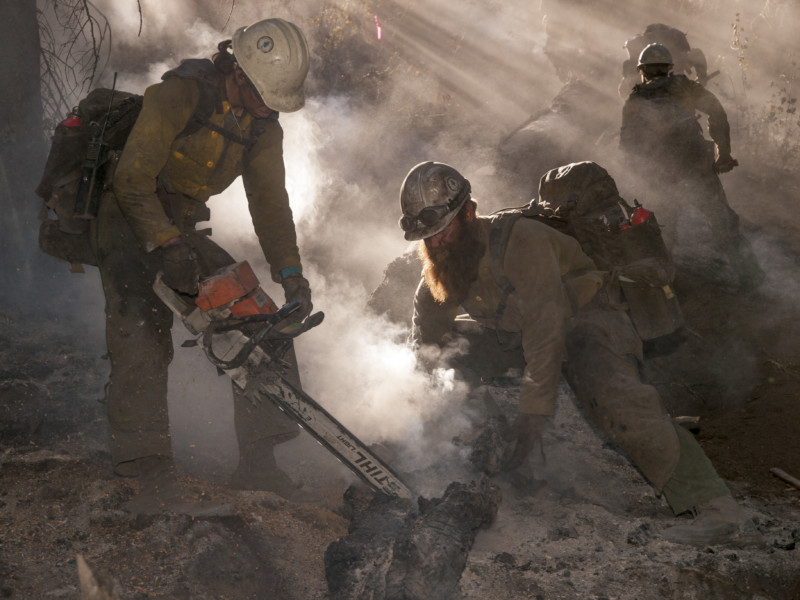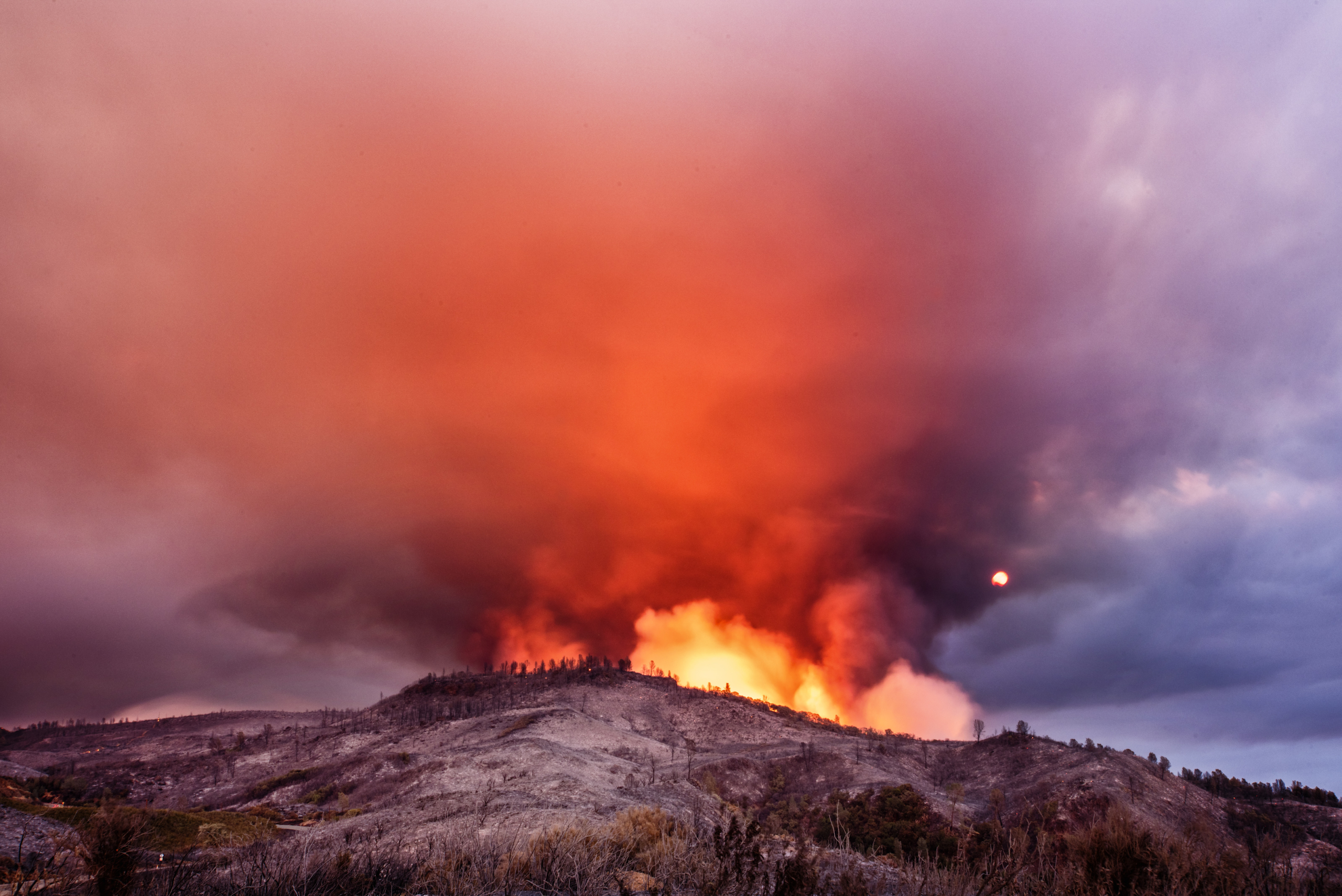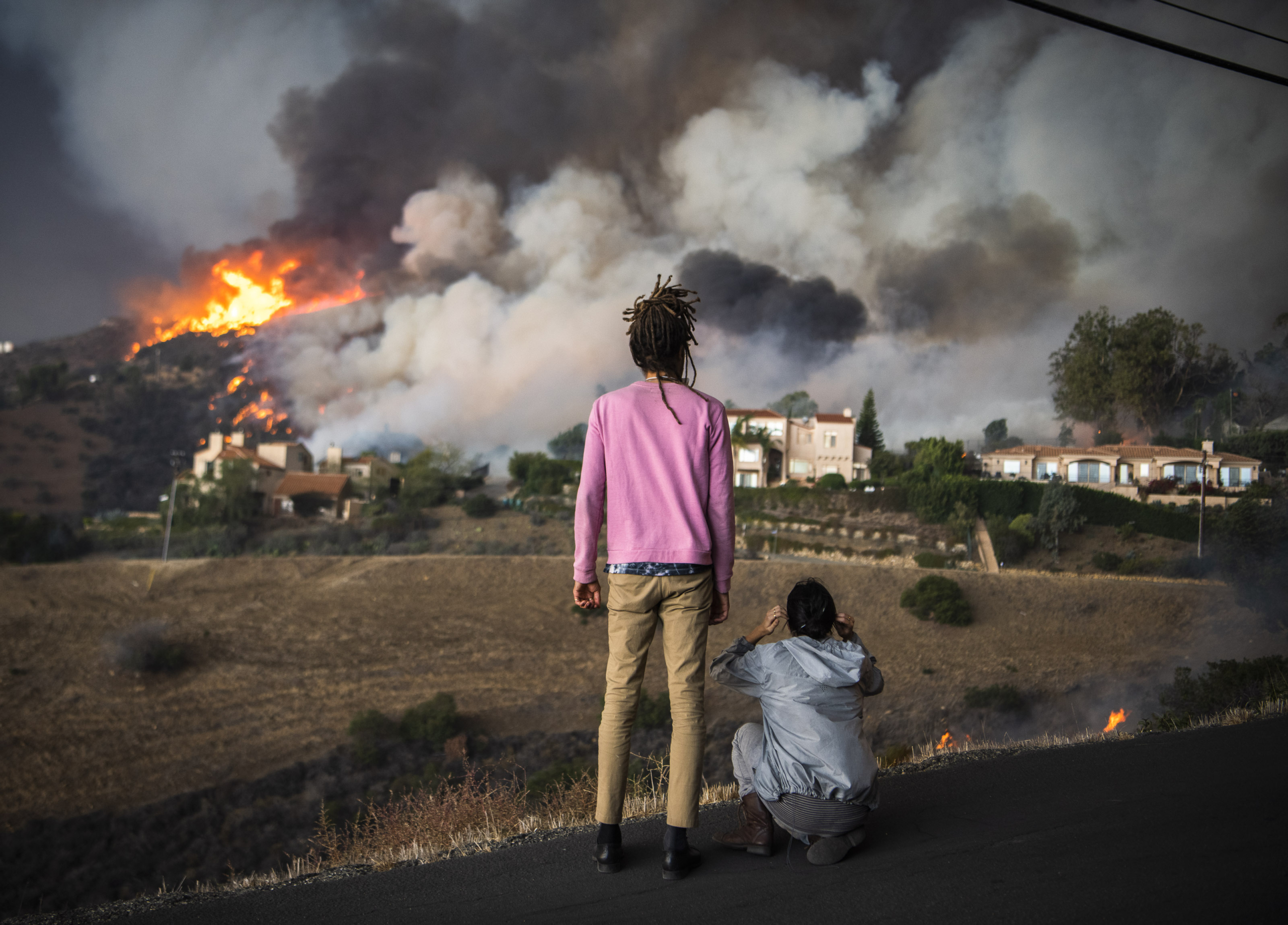Sign up for The Media Today, CJR’s daily newsletter.
At around 3am on November 9, 2018, photographer Stuart Palley stood on the sidewalk of a residential street in Thousand Oaks, California. A wildfire known as the Hill Fire was burning down from the foothills, driven by Santa Ana winds and fueled by unseasonably hot and dry conditions. Palley had been on the scene for 13 hours. His fire-proof clothing, boots, and helmet were covered in soot.
“I had a gut feeling something was about to happen,” Palley says. “I saw a firefighter pounding on the front door of one home and I thought, ‘Holy shit, somebody’s still inside.’”
Palley raised his camera just as the resident came running out of the front door wearing only his boxer shorts and a T-shirt, wincing at the flames around him as he fled. Palley snapped a picture that Time magazine named one of the top 10 photos of 2018.
“Countless images of destruction and heroism emerged from the fires in November,” Time’s editors wrote, “but none felt as intimately intense as this one by Palley: a man running for his life in the dead of night.”

A Thousand Oaks resident evacuates his home on November 9, 2018. Photo by Stuart Palley.
The Hill Fire ultimately burned 4,500 acres, destroyed 4 homes, and caused 17,000 people to be evacuated. It was a mere firecracker compared to two other major fires, the Woolsey and Camp fires, that burned a combined 250,000 acres that same month, destroying over 20,000 structures and killing 88 people. Palley covered those fires, too, capturing night scenes that are the trademark of his long-term photography project, Terra Flamma.
ICYMI: Audiences are (finally) paying more attention to climate stories
Palley started the project in 2012 as a way to counteract the news media’s rote and repetitive wildfire coverage. “It was like the same picture and caption were being copied from one wildfire to the next: ‘Firefighters battle Fire X in rugged terrain, which has burned X amount of acres because of California’s dry, hot conditions,’” Palley says. “I wanted to make pictures with more depth and nuance to help people understand the impact of wildfire instead of just getting into the horserace of breaking news. By taking long exposures at night, I can put a fire in the context of its geography.”
Palley, who estimates he’s photographed 100 wildfires, understands such events are a natural component of California’s ecosystem. But the combined effects of climate change and drought, a century of misguided wildfire suppression (sorry, Smokey Bear), and urban sprawl have created new and aberrant versions.
The pictures are a mash-up of colors natural and not: pink clouds, dark blue night sky, twinkling Milky Way, red and blue emergency lights, LED car headlights. The effect is mesmerizing. Images from the Terra Flamma series have been published widely—National Geographic, Wired, The Washington Post—and have kept a national spotlight on California’s wildfires.
Hanging around wildfires at night isn’t practical, or legal, for most photographers in the United States. According to the Freedom Forum Institute, an educational partner of the Newseum, California is one of only three states that guarantees media access to disaster scenes. (The other two are Alaska and Ohio.) California’s Penal Code reads that a journalist must be a “duly authorized representative of any news service” to get access. Palley wears a lanyard with a badge that reads “News Media, On Assignment!”
“Usually, I’ll have five or six outlets assigning me to cover a fire,” he says. “But if a fire breaks out before I get an assignment, I have an agreement to work as a stringer for Zuma. I’ll upload images from my camera to my phone, making them available to any editor who uses that wire service.”
But on federal lands, media access to wildfires remains tricky even in California. Case law has ruled in favor of the news media, protecting their right to the First Amendment, but those rulings don’t do much good in the heat of the moment.
Palley is among a handful of photographers in the United States to have gained “vendor” photographer status for the Forest Service.
“It’s basically like being a freelancer for the Forest Service,” Palley says. “I own all the photographs and can use them for my purposes, commercially. The Forest Service is allowed to use them for education, training, public outreach, and media use.”
In today’s political climate, it seems surprising that a federal agency would pay a member of the media to document a topic so closely related to climate change as wildfire. Karin Greer, a veteran contract photographer for the Forest Service, sees the arrangement as being in the Forest Service’s and the public’s best interests.
“When a wildfire breaks out, one of the first things an incident command center needs is public outreach,” Greer says. “They contract with us to document the nitty-gritty of the fire—the personel, techniques, and equipment involved—for them to use in public relations briefings. We have a synergistic relationship.”
Greer worked as a bonafide firefighter before becoming a contract photographer. A requirement for all Forest Service vendors is they attend wildland firefighting training.
“I feel like a firefighter whose tool is a camera,” she says. “Firefighters are a tight community. It’s almost like in the military where it’s a brotherhood and sisterhood kind of thing. This is my tribe and I feel like I’m working for the greater good. By establishing relationships with people on the ground, I am on scene and ready to roll when the fire breaks loose and it’s ‘go time’.”

Photo by Kari Greer
As de facto embeds on forest service wildfire crews, contractors are privy to intimate moments not easily witnessed by staff or freelance photographers arriving on day shoots. And with the Forest Service sharing images by photographers of Greer and Palley’s caliber, editors have a legitimate alternative to sending their own photographers into harm’s way.
Then again, the challenges of reporting on Californian wildfires have also served as a force for innovation in newsrooms across the state. The Press Democrat, a newspaper based in Santa Rosa, won the 2018 Pulitzer Prize for Breaking News Reporting for its coverage of the October 2017 Tubbs Fire. Their reporting included immersive photography and videography seemingly taken from inside the inferno. And the collaborative project Destined to Burn saw nine news organizations (The Sacramento Bee, Chico Enterprise-Reporter, The Paradise Post, The Record Searchlight, Reno Gazette-Journal, Ventura County Star, Desert Sun, USA Today, and the Associated Press) join forces to produce in-depth reporting about the consequences of and solutions to wildfire in California.
“Every year,” says Lauren Gustus, editor of The Sacramento Bee, “we get better at reporting wildfires. We just hosted CAL Fire for a media training day. Folks from the Associated Press and some local freelancers joined us. It was constructive to hear the questions everyone asked and to talk about how we can engage in safe coverage on the fireline.”
As a McClatchy newspaper, The Sacramento Bee has been part of a regional reorganization aimed at streamlining the coverage of overlapping issues such as wildfire. “Historically, there could be a photographer from The Fresno Bee, The Modesto Bee, and The Merced Sun Star showing up at the same place to do the same job,” Gustus says. “We would frustrate each other because nobody has the resources to do that anymore. We can be a lot smarter about how we work by creating geographic zones of coverage. We’re also creating a fire strike team that can flex in and out as needed, because when you cover a fire, oftentimes it can be weeks on end and you do need to send people in and out to keep them fresh and safe.”
Nationally, the news media has been searching for ways to report on natural disasters in a way that conveys warnings about climate change. An increasingly popular approach is to tell aftermath stories, such as The New York Times’s report about a home in Florida’s panhandle that withstood Hurricane Michael’s 250 mph winds. Similar stories were reported by CNN, The Weather Channel, and Popular Science, among others. Wildfire versions of that story have been published in The Wall Street Journal, The Washington Post, NPR, and others.
“We also went looking for a ‘Michael’ house in Paradise,” Gustus says. “But we learned that wildfires impact communities different than hurricanes. Fire rips through, burning some houses but not others. There are certain factors that can affect whether a home burns or not, like defensible space and active fire mitigation. But we didn’t think it was responsible to say any single home was left standing because of X, Y, or Z. Maybe it was just lucky because of how the embers fell.”
The Sacramento Bee’s coverage focused largely on stories of human survival. Their documentary “When Paradise Became Hell,” which includes stories from the newspaper’s photographers and reporters, was a finalist for the 2018 Northern California Area Emmys.
Palley, by contrast, has focused on what goes missing in the aftermath of a wildfire. His follow up to Terra Flamma is a project tentatively called “The Place Left Behind.” The idea was inspired, in part, by the suicide of a smokejumper he’d photographed in 2016.
“When I heard the news, I wrote on Instagram that I was there to listen for anyone needing to talk,” Palley says. “Within two hours, people were calling and messaging me. It drove home the emotional cost of fighting wildfire.”
This spring and summer, Palley embarked on a 4,500-mile road trip to photograph the hallowed ground of some of the American West’s most tragic fires: Storm King Mountain in Colorado, Mann Gulch in Montana, and the Big Burn in Idaho. Along the way, he saw homes built amidst fire-prone forests.
“Given the trajectory of climate change, I have a growing sense of unease that it’s only going to get worse,” Palley says. “More homes are going to burn, and more people are going to die. I want to show that when wildfires burn, they combust into more than just flames.”
COVERING CLIMATE NOW: A new commitment to covering the climate story
Has America ever needed a media defender more than now? Help us by joining CJR today.









